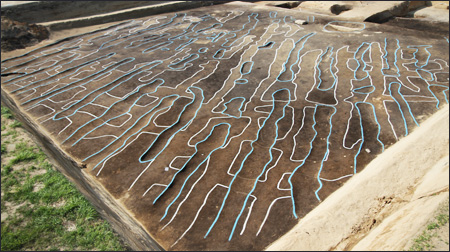Neolithic farm field found in Gangwon Province

This picture shows the remains of a farm land dating back to the Neolithic Age in Goseong, eastern Province of Gangwon. The National Research Institute of Cultural Heritage said that this is the site of a farm land ever disdovered in East Asia / Yonhap
Researchers have found evidence proving that farming took place in Korea 5,000 years ago.
The National Research Institute of Cultural Heritage said Tuesday that archaeological traces presumed to be East Asia’s first Neolithic remains of an agricultural field have been found in a northern province.
The discovery in Goseong, Gangwon Province, reveals that prehistoric people who lived on the Korean Peninsula began to cultivate crops during the Neolithic period.
The institute is affiliated with the Cultural Heritage Administration under the Ministry of Culture, Tourism and Sports.
It unveiled two layers of the Neolithic field, dating back to 3600-3000 B.C., during a news briefing, Tuesday. Previously, the oldest farming field located in Korea dated back to the Bronze Age (1500-400 B.C.).
“There has been a presumption that agricultural fields may have existed on the peninsula during the period based on farming-related stone tools and carbonized grain found in remains from the period, but the recent find was the first discovery of traces supporting the presumption,” an official with the institute said. “No such evidence has yet to be found in China or Japan.”
Researchers found some pottery and an arrowhead made of stone from the field.
In China, it is believed that farming started during the early Neolithic Period, but no evidence has yet to be discovered to support this.
“The latest find enables a more detailed study of Neolithic farming in Korea. Thorough a scientific analysis of the soil, we will be able to learn more about the exact dates of the field and the kind of crops that were cultivated there,” the official said.
Goseong, 466 kilometers east of Seoul, has been an important location for researchers of prehistory of East Asia.
The field unveiled on Tuesday is located in Munam-ri, Goseong, which was previously designated by the government as a historic site after some Neolithic relics were found in 1998. In 2002, researchers discovered prehistoric earthenware, jade earrings, among other items in the area. <The Korea Times/Do Je-hae>

























































